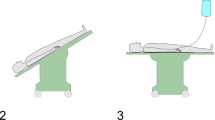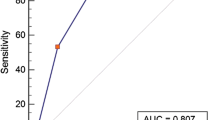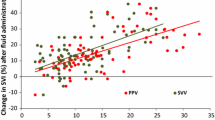Abstract
Fluid management is challenging in infants after cardiopulmonary bypass. Pulse pressure variation (PPV) derived from pressure recording analytical method (PRAM) is based on lung–heart interaction during mechanical ventilation. A prospective observational study conducted in operating room tested PPV to predict fluid responsiveness in ventricular septal defect infants. Infants in open chest conditions with median sternotomy (n = 26) or minimally invasive right thoracotomy (n = 29) undergoing ventricular septal defect repair were enrolled. After cardiopulmonary bypass and modified ultrafiltration, all patients received fluid challenge. PPV was recorded using PRAM along with heart rate, diastolic blood pressure, stroke volume index (SVI), and cardiac index (CI) before and after volume replacement. Patients were considered as responders to fluid loading when CI increased ≥15%. In infants with median sternotomy, 12 were responders and 14 non-responders. PPV in responders was higher than that in non-responders (24.7 ± 6.4 vs. 16.6 ± 5.0%, P < 0.01). Area under the curve was 0.85 (95% confidence interval, 0.69–1, P = 0.001) and cutoff value 19% with a sensitivity of 92% and a specificity of 71%. In infants with minimally invasive right thoracotomy, 16 were responders and 13 non-responders. PPV in responders was higher than that in non-responders (25.0 ± 6.8 vs. 18.2 ± 5.3, P < 0.01). Area under the curve was 0.83 (95 confidence interval, 0.66–0.98, P = 0.001) and cutoff value 18% with a sensitivity of 94% and a specificity of 69%. PPV sensitively predicts fluid responsiveness in ventricular septal defect infants after surgical repair in open chest conditions both with median sternotomy and minimally invasive right thoracotomy.


Similar content being viewed by others
References
Michard F, Teboul JL (2002) Predicting fluid responsiveness in ICU patients: a critical analysis of the evidence. Chest 121(6):2000–2008
Reuter DA, Goepfert MS, Goresch T, Schmoeckel M, Kilger E, Goetz AE (2005) Assessing fluid responsiveness during open chest conditions. Br J Anaesth 94(3):318–323. doi:10.1093/bja/aei043
Cannesson M, Aboy M, Hofer CK, Rehman M (2011) Pulse pressure variation: where are we today? J Clin Monit Comput 25(1):45–56. doi:10.1007/s10877-010-9229-1
Marik PE, Cavallazzi R, Vasu T, Hirani A (2009) Dynamic changes in arterial waveform derived variables and fluid responsiveness in mechanically ventilated patients: a systematic review of the literature. Crit Care Med 37(9):2642–2647. doi:10.1097/CCM.0b013e3181a590da
Biais M, Cottenceau V, Stecken L, Jean M, Ottolenghi L, Roullet S, Quinart A, Sztark F (2012) Evaluation of stroke volume variations obtained with the pressure recording analytic method. Crit Care Med 40(4):1186–1191. doi:10.1097/CCM.0b013e31823bc632
Monnet X, Dres M, Ferre A, Le Teuff G, Jozwiak M, Bleibtreu A, Le Deley MC, Chemla D, Richard C, Teboul JL (2012) Prediction of fluid responsiveness by a continuous non-invasive assessment of arterial pressure in critically ill patients: comparison with four other dynamic indices. Br J Anaesth 109(3):330–338. doi:10.1093/bja/aes182
Renner J, Broch O, Duetschke P, Scheewe J, Hocker J, Moseby M, Jung O, Bein B (2012) Prediction of fluid responsiveness in infants and neonates undergoing congenital heart surgery. Br J Anaesth 108(1):108–115. doi:10.1093/bja/aer371
Teboul JL (2009) Meaning of pulse pressure variation during cardiac surgery: everything is open. Crit Care Med 37(2):757–758. doi:10.1097/CCM.0b013e318194d575
Reuter DA, Goresch T, Goepfert MSG, Wildhirt SM, Kilger E, Goetz AE (2004) Effects of mid-line thoracotomy on the interaction between mechanical ventilation and cardiac filling during cardiac surgery. Br J Anaesth 92(6):808–813. doi:10.1093/bja/aeh151
Calamandrei M, Mirabile L, Muschetta S, Gensini GF, De Simone L, Romano SM (2008) Assessment of cardiac output in children: a comparison between the pressure recording analytical method and Doppler echocardiography. Pediatr Crit Care Med 9(3):310–312. doi:10.1097/PCC.0b013e31816c7151
Giomarelli P, Biagioli B, Scolletta S (2004) Cardiac output monitoring by pressure recording analytical method in cardiac surgery. Eur J Cardiothorac Surg 26(3):515–520
Wernovsky G, Wypij D, Jonas RA, Mayer JE Jr, Hanley FL, Hickey PR, Walsh AZ, Chang AC, Castaneda AR, Newburger JW, Wessel DL (1995) Postoperative course and hemodynamic profile after the arterial switch operation in neonates and infants. A comparison of low-flow cardiopulmonary bypass and circulatory arrest. Circulation 92(8):2226–2235
Yazine M, Cyrille P, Arnaud F, Elie Z, Eric L, Francois T, Claude G, Michel S, Herve D (2009) Assessing fluid responsiveness in critically ill patients: false-positive pulse pressure variation is detected by Doppler echocardiographic evaluation of the right ventricle. Crit Care Med 37(9):2570–2575
Marik PE, Baram M, Vahid B (2008) Does central venous pressure predict fluid responsiveness? A systematic review of the literature and the tale of seven mares. Chest 134(1):172–178. doi:10.1378/chest.07-2331
Scott DB, Slawson KB, Taylor SH (1969) The circulatory effects of the Valsalva manoeuvre during anaesthesia and thoracotomy. Cardiovasc Res 3(3):331–337
Jong-Hwan L, Yunseok J, Jae-Hyon B, Nam-Su G, Deok Man H, Jun Hyun K, Hyun Joo K (2011) Pulse pressure variation as a predictor of fluid responsiveness during one-lung ventilation for lung surgery using thoracotomy: randomised controlled study. Eur J Anaesthesiol 28(1):39–44
Choi DY, Kwak HJ, Park HY, Kim YB, Choi CH, Lee JY (2010) Respiratory variation in aortic blood flow velocity as a predictor of fluid responsiveness in children after repair of ventricular septal defect. Pediatr Cardiol 31(8):1166–1170. doi:10.1007/s00246-010-9776-8
Garisto C, Favia I, Ricci Z, Romagnoli S, Haiberger R, Polito A, Cogo P (2014) Pressure recording analytical method and bioreactance for stroke volume index monitoring during pediatric cardiac surgery. Paediatr Anaesth 2(25):143–149. doi:10.1111/pan.12360
Ricci Z, Polito A, Netto R, De Razza F, Favia I, Carotti A, Cogo PE (2013) Assessment of modified ultrafiltration hemodynamic impact by pressure recording analytical method during pediatric cardiac surgery. Pediatr Crit Care Med 14(4):390–395. doi:10.1097/PCC.0b013e31828a7113
Author information
Authors and Affiliations
Corresponding author
Ethics declarations
Conflict of interest
None.
Additional information
Jia Li and Chuan Ou-Yang have contributed equally to this work.
Rights and permissions
About this article
Cite this article
Han, D., Liu, YG., Luo, Y. et al. Prediction of Fluid Responsiveness Using Pulse Pressure Variation in Infants Undergoing Ventricular Septal Defect Repair with Median Sternotomy or Minimally Invasive Right Thoracotomy. Pediatr Cardiol 38, 184–190 (2017). https://doi.org/10.1007/s00246-016-1500-x
Received:
Accepted:
Published:
Issue Date:
DOI: https://doi.org/10.1007/s00246-016-1500-x




